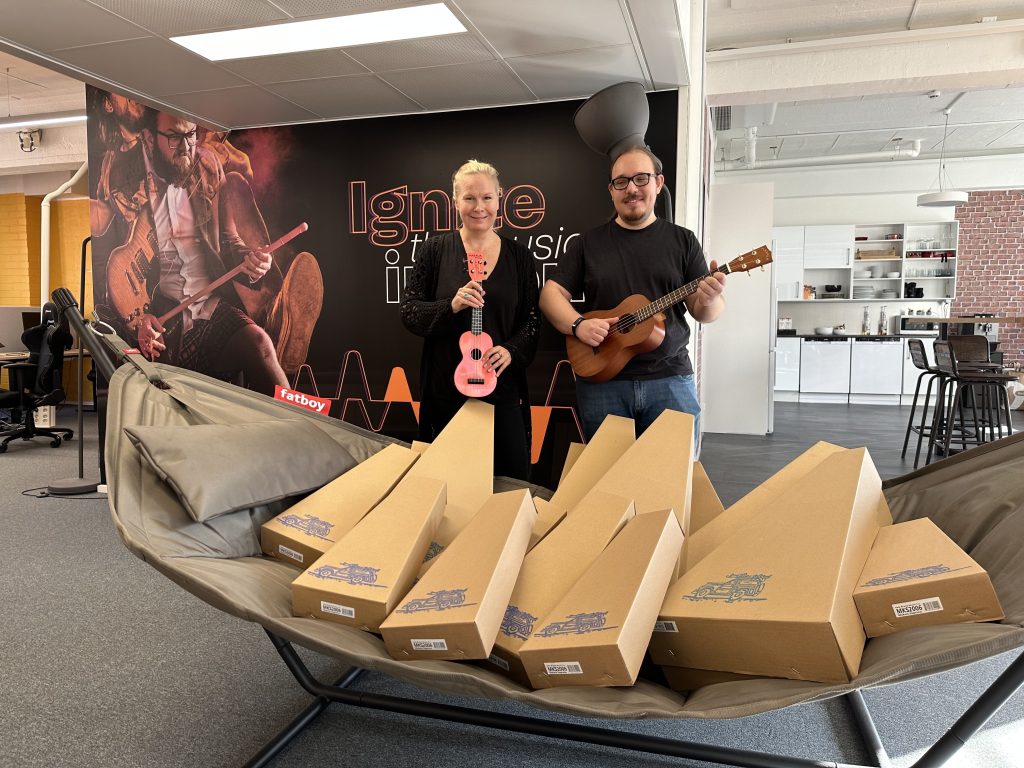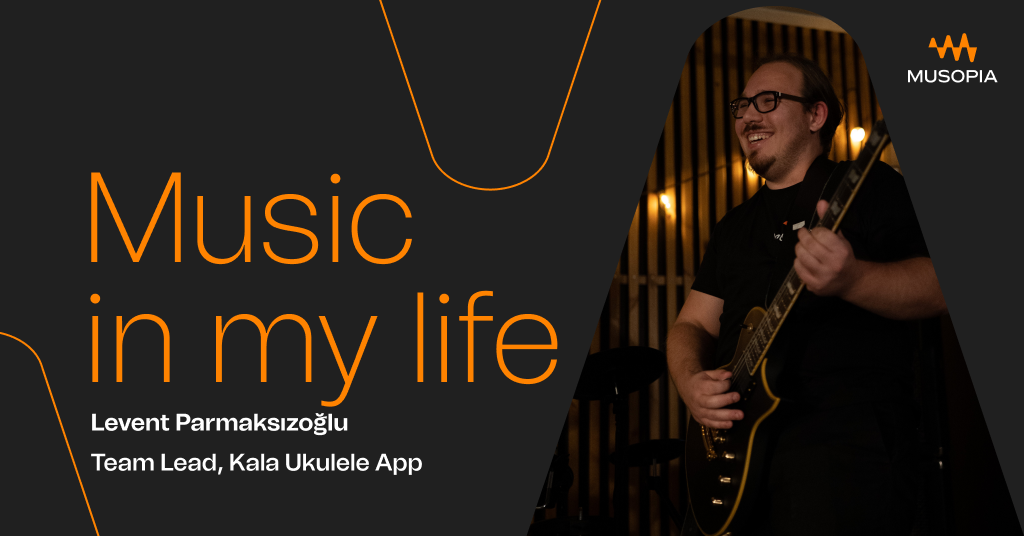We sat down with Levent, mobile developer and Team Lead of the Kala Ukulele App and found out why Musopia is a great place to work from a developer’s point of view.
How long have you worked at Musopia?
I joined in October 2021, so it’s been two years already.
Why did you want to work for Musopia?
I had long wanted to work for an international company, and Musopia caught my eye. And especially after seeing the music tech connection, I knew I just had to get the job.
Where have you worked before Musopia?
My first job in software was at Sanlab, a Turkish company manufacturing Training Simulators and Motion Platforms. Then, I worked at RestPlay making mobile casino games for about two years.
What do you like best about working at Musopia?
Oh, there are many great things: the hybrid working system, work-life balance, and flat hierarchy, to name a few. The office music studio is also a major plus; we can, at any time, just go in and jam!
Making music is one of the biggest drivers for me. It’s one of the few things in life that offers such long-term gratification.
What do you think are Musopia’s strengths?
It’s got to be the people. We have grown a lot in recent years since I joined and acquired the best talent around.
What is your area of responsibility at Musopia?
I am the Team Lead of our Kala Ukulele App. I get to plan and develop our roadmap, and I am responsible for implementing and releasing new features and enhancements. My core specialization is building UI elements and other user-facing features that feel responsive and satisfying.
How have you been able to develop your skills at Musopia?
I came from a game development background, and there were a lot of differences to the work here at Musopia, especially when it comes to live-ops. We do a lot of remote content management, which has been very interesting to learn about.
How would you describe the atmosphere and interactions among developers?
It’s pretty chill. There isn’t a strong top-down hierarchy, and everyone is free to speak their mind and contribute to anything. This was pretty cool for me, especially since I come from a country with more strict social roles, so it was really easing my mind to be able to just hang out on a first-name basis with anyone in the company, including our CEO. Overall, it’s a very respectful atmosphere where everyone’s ideas are valued.

Do you work independently or interact a lot with other developers?
I would say that it’s a bit of both. There can be a lot of interaction when working on a project together or when you need to ask for help from someone who knows it better, and there are also smaller things that you just develop by yourself. The practical coding itself is usually individual work, but it tends to happen after discussions to find solutions. If I get stuck somewhere or don’t know which is the best way to proceed, I’ll for sure ask someone who knows better than I do. And if it’s a task I’m very familiar with, I’ll go the route of legendary F1 driver Kimi Räikkönen: “Leave me alone; I know what I’m doing”.
How do you come up with the workflow?
It’s very collaborative. Usually, we’ll talk about the task and discuss the goals, requirements, UI/UX design and the specific tech we’re building as we’re starting it. If everything is clear, a developer can start working on it without needing too much further communication. We work on a scrum-like basis, and at the start of each sprint, we’ll divide the tasks based on priorities and the individual developer’s experience and interest. Some tasks, especially those that require cross-team collaboration, will involve more frequent interaction. Our company policy is to work on hybrid working mode, on average two days from the office, so sometimes communication happens face-to-face, and if not, we stick to our digital communication channels.
If it’s a task I’m very familiar with, I’ll go the route of legendary F1 driver Kimi Räikkönen: “Leave me alone; I know what I’m doing”.
What is your musical background?
I started playing the classical guitar when I was twelve and moved on to electric guitar a few years later. I played with some friends in a high school band, playing songs we liked for fun, and eventually composed a few songs ourselves. I also got into electronic music production and made some game music. I’ve started writing music again after moving to Finland, and recently, I’ve bought a lyre harp, so I’m currently learning that and incorporating it into my compositions.
Do you play any other instruments?
The guitar is still my ‘main’ instrument, although I’ve also picked up the bass and drums over the years.
What kind of music do you listen to?
These days, I mostly listen to various subgenres of metal, mainly Folk Metal, Power Metal, and a bit of Black Metal.
How do you feel music makes the world a better place?
It’s impossible to say since I cannot compare it to a world without music.
It’s a very respectful atmosphere where everyone’s ideas are valued.
What is the meaning of music in your life?
Making music is one of the biggest drivers for me. It’s one of the few things in life that offers such long-term gratification.
What is your guilty pleasure song, the song that you secretly love?
I don’t get guilty pleasure in music – if I like it, I like it. I haven’t felt the need to keep any songs I love secret.
What kind of coffee do you start your working day with?
Any kind that I can get my hands on. I’m not a picky person when it comes to coffee. And sometimes, I’ll enjoy a cup of tea instead.
Which famous musician would you like to jam with, if possible?
I’ll go with Thanasis Lightbridge, the musician behind projects Dol Ammad, Dol Theeta, and Dol Kruug. I adore everything he has made, so to jam with him would be great. Oh, and here’s another perk of working at Musopia: At last year’s Musopia Slush party, I played with Justin Sandercoe! One famous name down, and many more to go
Read the previous part of this series
Follow Musopia on Linkedin for the latest news

